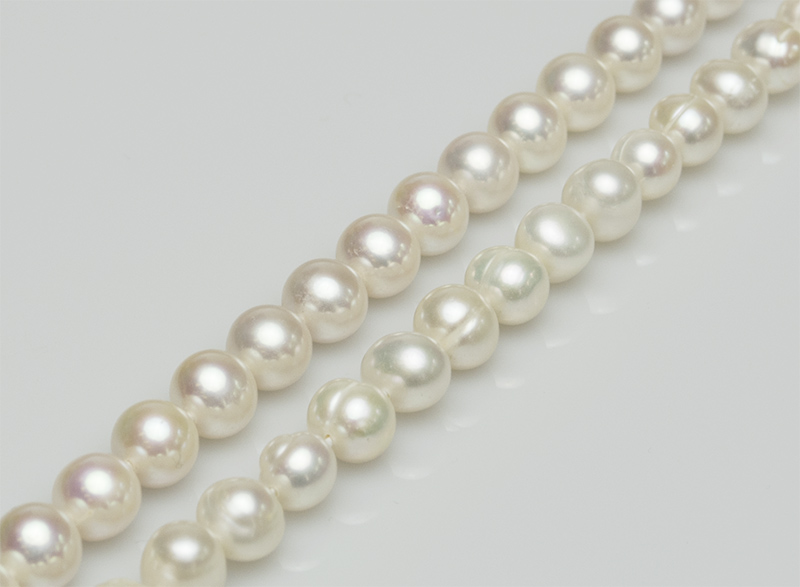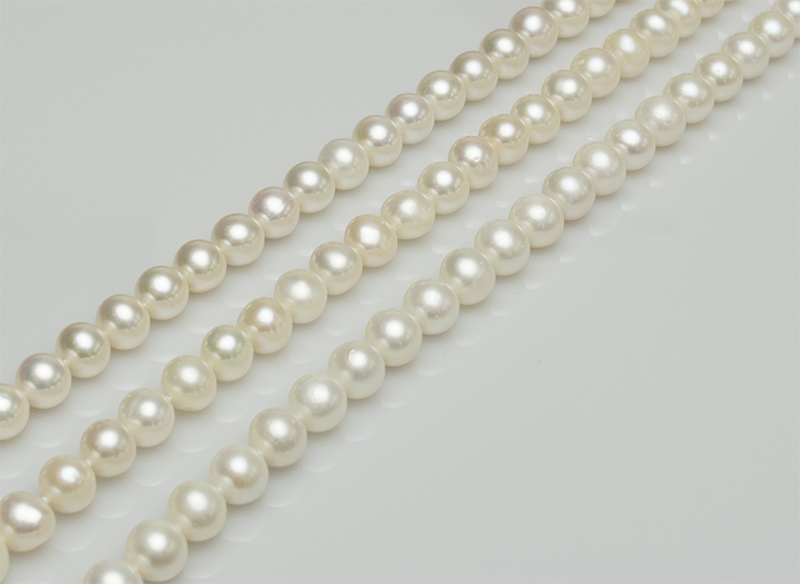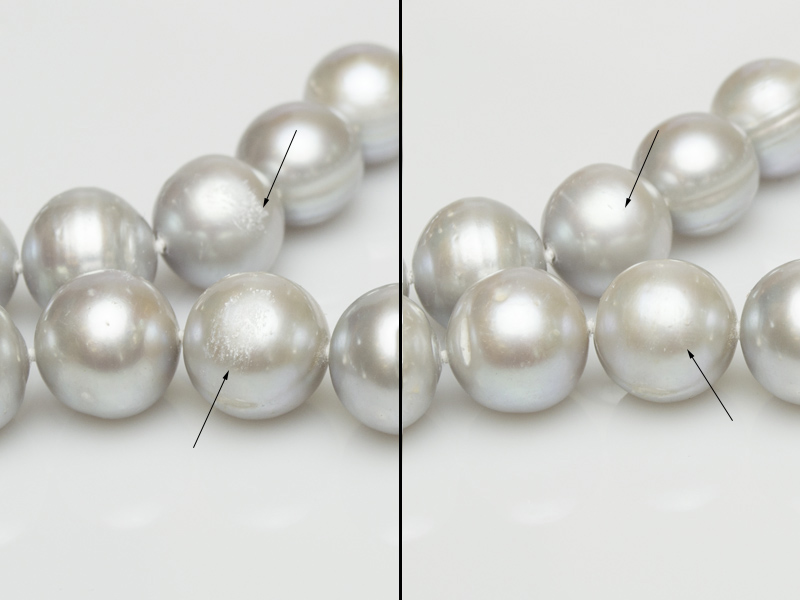How to distinguish real from fake pearls - or how not to buy an imitation?
- News
- 47 likes
- 53055 views
- 0 comments

How to distinguish real from artificial pearls - how not to buy imitations by mistake?
Due to their rarity and great value, pearls have been a coveted jewel among rulers and persons of the highest material status for thousands of years. Only a few could afford such jewelry.
Due to the large-scale cultivation of pearls, initiated on a large scale in the 20th century, their price has been significantly reduced, which in turn has led to the displacement of naturally fished pearls from the market in favor of cultivated ones.
It is worth noting, however, that still pearls with a shape similar to a ball of good quality are very expensive. No wonder that there are artificial equivalents on the market that imitate a real pearl.
There would be nothing wrong with that, if the counterfeits were properly marked and the person who buys the "artificial beads" was informed about this fact. According to international standards, all imitations of real pearls should have the word "imitation" in their name.
Therefore, it is unacceptable to sell imitations without explicitly specifying - which is, unfortunately, a very common practice among sellers. Usually, in imitations, we meet the description "pearl ... (in the place of the dots any proper name is inserted, for example the name of the company or place of production), for example the well-known" pearl Majorca "
Unfortunately, the world is not perfect and many people can deliberately mislead an unfamiliar customer. It would be good to be able to defend yourself against an unreliable seller and learn a little about these wonderful gems. In this article, we show you what to look for to distinguish real pearls from their artificial counterparts.
Despite the more and more effective counterfeiting techniques, there are several basic methods thanks to which each of us is able to check whether we are dealing with a counterfeit or a real product of nature.
At the beginning, however, it is good to know what affects the value of pearls, so that you can become suspicious of authenticity at the price alone. You can read about it in our other article - read more.
Pearl weight and temperature
The first thing we should pay attention to is weight. Pearls are quite heavy. Their weight is similar to glass or marble. Imagine that you are holding glass marbles in your hand. Pearls should be more or less of this heaviness.
In addition, real pearls are cold to the touch. So if you pick up the necklace, you should feel a chill. Only after a good few seconds of holding should they gain warmth.
In the case of most artificial pearls, you will not notice this effect. The fakes will be warm immediately (as if we grabbed something made of plastic).
Shape of pearl
Real pearls are almost never perfectly round. Roundness is practically impossible in freshwater pearls. Sea pearls are usually more even, but also imperfect.
Even if the pearl appears to be a ball, on careful measurement it will probably show some deviations. It's best to get a caliper for this measurement. The differences can be very small, e.g. 0.1 mm, therefore the measurement must be accurate.
However, it should be remembered that pearls (in the case of a necklace) with such a spherical shape will already be expensive. From about a thousand for smaller pearls to ... - the upper limit may not be, but the prices will certainly be counted in many thousands.
 A preview of different types of pearl shapes - from the left: baroque, oval, button, round
A preview of different types of pearl shapes - from the left: baroque, oval, button, round
It is easiest to measure a pearl that has not yet been threaded, e.g. in earrings, but you can also measure it in a necklace or bracelet.
Round pearls, even according to the standards of the International Jewelery Association, may have deviations of several percent. In fact, the less equal the pearls are, the more likely they are to be real. Especially if we don't buy pearls in the price equivalent of a car
Pearl surface
Of course, there are pearls with a flawless surface, but they are, of course, very expensive. First of all, such pearls are intended for gold products, such as rings, pendants or earrings.
In necklaces and bracelets, we will not find such pearls, unless we pay enough. Even if the necklace costs many thousands of zlotys, there will be single blemishes on the pearls.

When buying imitations, their surface is usually smooth and without any holes, scratches or differences in color. If your pearls have any imperfections, they are most likely real.
Pearl colour
As with the surface, the color of the pearls is not perfectly uniform. The easiest way to notice the differences is in dark pearls, which are characterized by a large range of secondary colors (the so-called overton). When viewing a pearl, its color will change slightly or more depending on the slope. On white pearls, we usually see faint pink, yellow or blue flashes. Mainly green, purple and navy blue in the dark.
Each pearl on the string will be more or less similar in color, but not identical. One will always be a bit lighter or with a slightly different color saturation. The pearls in your necklace will not be of the same color, although it is best if they are very similar. This is of course, as always with the rest, a high price.
Fitting pearls
When it comes to pearl jewelry, matching them to each other is an important issue. We are talking here not only about shape, but also about size, color and the surface itself.
In good quality earrings it can be hard to see the difference between two pearls, but with a necklace or bracelet it is quite possible and easy if you look closely.
However, all kinds of fakes are usually identical. Remember that even with pearls for at least several thousand zlotys, you will see the differences after zooming in
Be sure to read these message from our clients that trusted us already :)
Pearl shine
Just by the gloss, it is not easy to distinguish real pearls from imitations. Many artificial pearls are manufactured in such a way as to primarily imitate sparkle. However, in imitations, this glow is "shallow".
In real pearls, the shine comes out from the depths. This is because pearls are made of layers of mother-of-pearl that are stacked on top of each other. As these layers are slightly transparent, the subsequent ones also emit a glow, thus giving the effect of depth.
 The difference in the shine of real pearls
The difference in the shine of real pearls
However, the expertise of pearls in this respect requires comparison and experience, so it is better not to risk and base your assessment only on this aspect. Especially that good counterfeit products also have a surface made in layers.
The friction method
A very nice method that eliminates most of the imitations. Real pearls are quite rough. We can't feel it in our hand - then they seem very smooth.
But you just need to rub the pearls against each other to feel the rubbing. Let's not be afraid to apply a little force, because without it we will not feel the difference.
It is also worth looking at the place of friction. We will see minor abrasions and light dust (even if the pearls are very dark). Have we just destroyed our pearls… ?! Take it easy, just rub your hand over this place for everything to return to normal. However, do not use too much force because then we can actually damage the pearls.
 The method friction Real Pearls Left: bright dust after rubbing pearls with each other
The method friction Real Pearls Left: bright dust after rubbing pearls with each other
In any case, most counterfeits will slide a lot (instead of resisting) and we can easily detect it. If we only have one pearl, we can try to rub it against the front tooth.
We should also feel the roughness of the surface. Here, we especially recommend doing it gently, as it is easier to make a deep scratch that may remain visible
The reflection of the pearl
All pearls, whether natural or cultured, are quite resilient. When released slowly from the height of a lowered hand onto a smooth glass surface, they should reflect about half of their height (plastic imitations will bounce much higher, and glass imitations lower).
We will achieve a similar effect on smooth tiles. The problem, however, is that we rarely deal with single pearls in a store, and only such pearls can be objectively assessed.
Therefore, we do not recommend throwing the necklace around shop windows, because apart from the poor effect, we can expose ourselves to the staff;)
Boiling water
Some counterfeit products under the influence of hot water may deform and lose their shiny surface. Nothing will happen to these real pearls, even if we leave them in boiling water for a long time.
Pearl jewelry finishing
Pearls are a valuable product and are finished according to their value. First of all, pearl jewelry is mostly made of silver or gold. So if we have perfect balls with a beautiful surface in front of us, but the clasp is made of cheap metal, we should be especially vigilant.
The low price does not suit such pearls, and the cheap metal finish in expensive pearls can only be used when it is still a semi-finished product that is only to be tied.
In the case of necklaces and bracelets, it is also worth paying attention to whether they are knotted. The knots between the pearls provide double protection - against the rubbing of the pearls on each other and against their scattering in the event of a possible breaking of the jewelry. In counterfeits, this is practically not used because it requires more work
Known imitations of real pearls
You can find a lot of imitations made of various materials on the market. The most famous counterfeits on the Polish market include those under the name:
Majorica - very popular imitations, which, unfortunately, are often confused with real pearls. As it is a regional product and produced by one company, it happens that they are also sold with a certificate, which can also be confusing about their naturalness. However, they are made only by hand from glass or porcelain balls, on which subsequent layers are applied. At first, they are colored and protected with a protective varnish. After that, multiple layers of paste made of oil and ground fish scale or mother-of-pearl are applied. They are very even and very shiny.
Fun fact: even imitations of Majorica pearls have their fakes. So we are dealing with counterfeit products :)
Shell (often also referred to as Seashell) - it is an artificially formed ball made of a shell (or a mass made of a powdered shell). A characteristic feature of these pearls is their perfect roundness and smoothness, as well as a very low price.
Swarovski Elements - these are imitations of pearls made of Swarovski crystal, which are covered with a pearl coating. They come in 29 colors, so it's relatively easy to recognize them by their identical shade.
 On the left an imitation, on the right real pearls
On the left an imitation, on the right real pearls
Summary
Having such knowledge about pearls, you can approach the purchase with greater awareness and detect imitations much easier. Remember, however, that when we buy really nice pearls at a high price and we have any doubts, it is better to consult an expert or a really good jeweler. And most of all, buy in specialized stores.
P.S. Are you wondering which pearl in the first picture is real? On the left is an imitation (Shell), on the right is a real pearl :)
Did we mention that you can get a discount? Check how without limits as to the time or size of the order :)


comments (0)